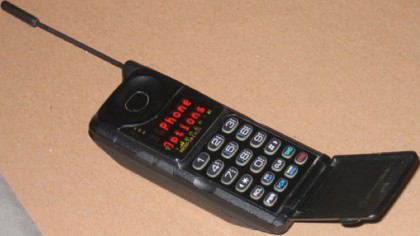Your old Nokia sucked: here's how much better phones have become in 20 years
No wonder everyone was miserable in the 90s: just check these specs!
Let's take a deep breath: the Moto X has NFC, Bluetooth 4.0 LE, dual-band 802.11a/g/b/n/ac Wi-Fi, GSM, GPRS, EDGE, UMTS, HSPA+ and 4G LTE. It has GPS and a Micro USB connector and it can connect to the Moto Hint wireless earbud, Android Wear smartwatches, wireless speakers, health and fitness monitors and in-car entertainment and navigation systems.
The Nokia's simple features required an entire phone; now, they're just another app.
To give you an idea of the difference between speeds then and now, in 1994 Network World magazine tested multiple cellular modems and found that the fastest one transmitted graphics at 71.2 kilobits per second.
In theory 4G LTE is capable of 300 megabits per second, which is 4,213 times faster. That would download a 5GB HD movie in just over two minutes; on 1994's networks, that would have taken seven days - assuming that the connection stayed up that long and that conditions were perfect, neither of which would be very likely.
Battery life
The Nokia 232 had various removable batteries depending on what you bought and where you bought it: a 380 mAh nickel cadmium battery offering 50 minutes of talk time and 10 hours standby, an extended 800 mAh NiCd offering nearly two hours of talk time, and ultimately the Ultra Extended nickel metal hydride battery delivering a whopping 2 hours and 30 minutes of chat and 32 hours on standby.
The Moto X ships with a 2,300 mAh battery that promises up to 24 hours of mixed use, although as with all battery figures that depends on signal strength and how you use your phone.
Comparing that to the Nokia makes it look like we've gone backwards with batteries, but of course the Nokia battery didn't have to drive a five-inch full HD display, lightning-fast 4G and a quad-core Snapdragon processor clocked at 2.5GHz.
Get daily insight, inspiration and deals in your inbox
Sign up for breaking news, reviews, opinion, top tech deals, and more.
The Nokia's simple features required an entire phone; now, they're just another app.
Storage
The 232 was very technically advanced for the time: it was capable of storing an incredible 98 telephone numbers. The internal storage was good for phone numbers of up to 30 digits and names of up to 16 characters (subject to a maximum combined total of 28 characters, so a 20-digit number could only have an 8-character name).
It could also store up to 20 DMS (Digital Message Service) messages of up to 14 characters each. Once that storage was full it was full: SD cards were still years away.

Storage is almost irrelevant now that we all live in the cloud and terabytes of free storage barely raise an eyebrow, but you still need room for apps and other key data that you need stored locally.
The Moto X has 16GB or 32GB of internal storage - but it's one of the very few modern smartphones that isn't also expandable via a micro SD card (Apple is the other big SD card refusenik). Nevertheless, even 16GB is enough to store thousands upon thousands of ebooks.
Price
The Nokia 232 launched with an RRP of £49.99 (with contract, which equates to £82 today), which doesn't sound like much - but back then a pint of lager was £1.58, the average wage was just over £17K and the average house price was £50K.
As with all technology, prices fell fast: by 1996 you could pick up the little Nokia for as little as £19.99 with a Cellnet contract.
The Moto X comes with the usual dizzying array of contract deals, so for example it's currently available for £119 up front and £18.99 per month on T-Mobile. SIM-free versions are currently around the £400 mark. In real terms, then, the Moto X is much cheaper than the Nokia was 20 years ago.
Isn't living in the future brilliant?
Writer, broadcaster, musician and kitchen gadget obsessive Carrie Marshall has been writing about tech since 1998, contributing sage advice and odd opinions to all kinds of magazines and websites as well as writing more than a dozen books. Her memoir, Carrie Kills A Man, is on sale now and her next book, about pop music, is out in 2025. She is the singer in Glaswegian rock band Unquiet Mind.
